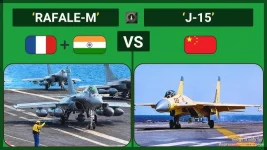- Views: 2K
- Replies: 7
The Indian Air Force (IAF) is showing significant interest in a new high-altitude surveillance aircraft being developed by Tata Advanced Systems Limited (TASL).
The platform, based on a German corporate jet, is being re-engineered into a manned High-Altitude Long-Endurance (HALE) aircraft designed for critical intelligence, surveillance, and reconnaissance (ISR) missions along India's borders.
This development marks a major step in India's indigenous defence manufacturing capabilities, offering a versatile and cost-effective solution to enhance the nation's aerial surveillance power.
In a strategic move in 2021, TASL, a key defence arm of the Tata Group, acquired the full intellectual property (IP) rights for the Grob G 180 SPn.
Originally a low-wing, twin-engine corporate jet made of advanced composite materials by German manufacturer Grob Aerospace, the aircraft never entered mass production due to financial issues.
TASL identified its potential and is now transforming it into a robust military platform. The re-engineered aircraft is designed to operate at altitudes up to 45,000 feet with an endurance of six to seven hours and a mission range of 1,800 nautical miles (approx. 3,400 km).
The aircraft fills a crucial gap in the IAF's capabilities, which arose after the retirement of its high-flying MiG-25R reconnaissance planes.
While satellites and unmanned aerial vehicles (UAVs) are in use, the manned Grob platform offers a unique blend of operational flexibility, real-time human decision-making, and the ability to carry a heavy payload of over 1,000 kg.
This allows for the integration of multiple advanced sensors for signals intelligence (SIGINT), electronic intelligence (ELINT), and cross-border monitoring.
A significant advantage of this programme is TASL's complete ownership of the aircraft's IP. Unlike foreign military purchases, which often come with strict limitations, owning the IP allows India to customise the aircraft without restriction.
This enables the integration of sophisticated, locally developed sensor suites and ISTAR (intelligence, surveillance, target acquisition, and reconnaissance) payloads, aligning perfectly with the 'Make in India' initiative in defence.
Progress on converting the jet into a military asset is reportedly advancing well, with ongoing tests and payload integration.
The aircraft's versatility is further boosted by its ability to take off from and land on unprepared grass and gravel airstrips, making it ideal for deployment in the diverse and challenging terrains of India’s forward areas.
Technical Specifications and Capabilities
The modified Grob G 180 SPn platform is tailored for high-performance surveillance and reconnaissance operations.- Operating Altitude: 41,000 feet, with a maximum service ceiling of 45,000 feet, allowing it to stay clear of many ground-based air defence systems.
- Range and Endurance: A notable range of 1,800 nautical miles (approximately 3,400 km) and an endurance of 6–7 hours on station.
- Payload Capacity: Capable of carrying more than 1,000 kg of advanced sensors, high-resolution cameras, and electronic warfare equipment.
- Versatility: Enhanced operational flexibility with the ability to operate from short and unpaved runways in remote locations.
- Propulsion: Powered by two reliable Williams FJ44-4A turbofan engines, ensuring consistent performance at high altitudes.

